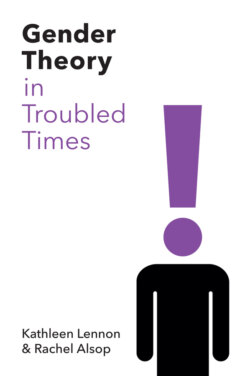Gender Theory in Troubled Times

Реклама. ООО «ЛитРес», ИНН: 7719571260.
Оглавление
Rachel Alsop. Gender Theory in Troubled Times
Contents
Guide
Pages
Dedication
Gender Theory in Troubled Times
Copyright page
Preface
Introduction. What is gender?
Doing gender theory
Theoretical shifts
Gender essentialism
The rise of right-wing populism
Gender theory under attack
The boundaries of the category ‘woman’
The structure of this book
Notes
1 The Data of Biology
Sexed/gendered difference
Sexed categories as natural kinds
Psychological and behavioural sex differences and their biological anchorage
Evolutionary psychology
Male and female brains
The sex/gender distinction
How many sexes are there?
The case of sport
Trans bodies and biology
Nature/culture and the new materialism6
Entanglements
Notes
2 Gendered Psyches: Psychoanalysis and Sexual Difference
Psychoanalysis
Why Freud?
The bodily ego
Freud and sexual difference
The boy
The girl
Sexual difference: in summary
Reflections
Lacan’s three orders
Lacan and sexual difference
Symbolic essentialism
The importance of the Imaginary
Luce Irigaray and the feminist imaginary
The inevitability of sexual difference?
Colonizing gestures
Psychoanalysis: race and disability
Conclusions
Notes
3 Historical Materialism
Gendered societies
Box 3.1
From Marxism to Marxist feminism
Second-wave Marxist feminism
Patriarchy
Historical materialism and patriarchy
Dual-systems theories and their critique
From patriarchy to gender regimes: Walby and Connell. Walby on gender
Connell on gender
Historical materialism and globally connected inequalities
Conclusions
Notes
4 Simone de Beauvoir: Becoming Woman
Phenomenology
‘Woman’ as situation
The One and the Other
Volume 1: The objective conditions. The data of biology
Economic and social structure
Myths
Volume II: Lived experience
Objectification
Living bodily difference
Bodily habits
Life paths
Complicity
Dimensions of otherness
Conclusions
Notes
5 Intersectionality
Intersectional analysis and material positionality
Intersectionality and lived experience
Intersectionality: the origins of the concept and the coining of the term
Intersectionality in practice
Which inequalities does intersectionality cover? The ‘etc. problem’
Who is intersectional?
The metaphor of the intersection
Decolonial feminism
Decolonial feminism and intersectionality
Intersectionality and subjectivity
Conclusions
Notes
6 Judith Butler: Performativity, Precariousness and Queering
Performance and performativity
Gendered scripts
Subjectivity and subjectification
Real genders
Precariousness
Queering
The performativity of race
The critique of identity
What about the body, Judy?
The expressive body and queer phenomenology
Other materialities
Conclusion
Notes
7 Making Sense of our (Gendered) Selves
The ‘trans’ umbrella
Gendered categories
Local readings
Confronting nature
Trans narratives and gendered homes
The dangers of spatial metaphors
Belongings
The wrong body
The expressive body
Transformative possibilities
Conclusion
Notes
Conclusion: The ‘Truth about Gender’
Sites of agency
Gender-based violence
Toxic masculinity
Coalition politics
Notes
Questions for Further Reflection. 1 What role does the body play in constituting gendered identities? Relevant book chapters/sections:
Further reading:
2 How should sport deal with gender fluidity? Relevant book chapters/sections:
Further reading:
3 Why is body image a key issue for gender studies? Relevant book chapters/sections:
Further reading:
4 What is the imaginary? What role does it play in gender theory? How can it be transformed? Relevant book chapters/sections:
Further reading:
5 Why have historical materialist frameworks been central to black feminist and decolonial perspectives? Relevant book chapters/sections:
Further reading:
6 Can gender equality be achieved within capitalism? Relevant book chapters/sections:
Further reading:
7 Is there a better term than ‘intersectionality’ to capture the complex relations between different elements of oppression and different elements of identity? Relevant book chapters/sections:
Further reading:
8 What role do bodily practices play in the production and reproduction of gender differences? Relevant book chapters/sections:
Further reading:
9 What role does the response of others play in the formation of our sense of (gendered) self? Relevant book chapters/sections:
Further reading:
10 Are gender and sexuality distinct? Relevant book chapters/sections:
Further reading:
11 How useful is the concept of toxic masculinity in explaining gendered violence? Relevant book chapters/sections:
Further reading:
Final points for discussion
References
Index
POLITY END USER LICENSE AGREEMENT
Отрывок из книги
In memory of Annette Fitzsimons
Much has happened to all the terms since then.
.....
The role of the Catholic Church is important here. From as far back as the 1990s, when the United Nations introduced the term ‘gender’ in its documents, its use was attacked by some Catholic groups. However, in the last few years that attack has intensified. Pope Francis complains that ‘indoctrination in gender theory’ is going around the world, undermining the natural and God-given division between the sexes and suggesting that sexual behaviour is not governed by objective moral norms (Glatz 2015).
What is clear in all these attacks is that gender theory is opposed because it is viewed as denying gender essentialism, suggesting instead that the divisions between the sexes, and the distinct characteristics and social positions assigned to each, are socially malleable. Gender theory, it is claimed, involves rejecting the naturalness of heterosexuality, the primacy of the heterosexual family and the fixity of gendered identity. In fact, gender theory is a broad area of study which includes many theorists who would endorse some versions of gender essentialism. In this book, however, while discussing alternative strands of theory, we proudly hold up our hands to opposing just the kind of gender essentialism that such populist movements seek to enforce. Their engagement makes clear that these apparently theoretical debates have highly political consequences.
.....